|
Gallinula chloropus (Common
moorhen)
Grootwaterhoender [Afrikaans]; Edenene (generic term for gallinules and
moorhens) [Kwangali]; Khohonoka [South Sotho]; Kgogomeetse/Kgogonoka
[North Sotho]; Nhapata (generic name for coot, gallinule, moorhen, crake
or rail) [Shona]; Kukumezani (generic name for moorhen or coot) [Tsonga];
Waterhoentje [Dutch]; Gallinule poule-d'eau [French]; Teichhuhn [German];
Galinha-d'įgua [Portuguese]
Life
> Eukaryotes >
Opisthokonta
> Metazoa (animals) >
Bilateria >
Deuterostomia > Chordata >
Craniata > Vertebrata (vertebrates) > Gnathostomata (jawed
vertebrates) > Teleostomi (teleost fish) > Osteichthyes (bony fish) > Class:
Sarcopterygii (lobe-finned
fish) > Stegocephalia (terrestrial
vertebrates) > Tetrapoda
(four-legged vertebrates) > Reptiliomorpha > Amniota >
Reptilia (reptiles) >
Romeriida > Diapsida > Archosauromorpha > Archosauria >
Dinosauria
(dinosaurs) > Saurischia > Theropoda (bipedal predatory dinosaurs) >
Coelurosauria > Maniraptora > Aves
(birds) > Order: Gruiformes >
Family: Rallidae
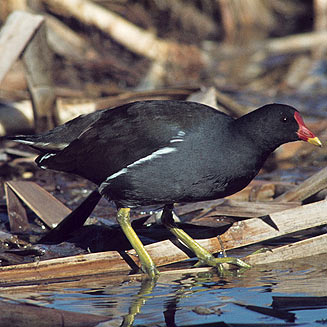 |
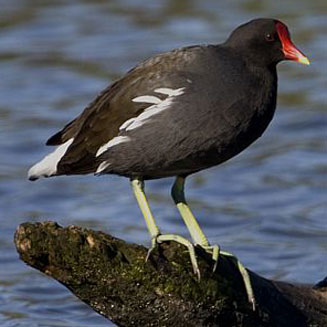 |
| Common moorhen. [photo H. Robertson ©] |
Common moorhen, Paarl Bird Sanctuary, South
Africa. [photo Trevor Hardaker ©] |
Distribution and habitat
Occurs extensively worldwide between 65° North and 40°
South, largely excluding forested and desert areas; it occupies much of
sub-Saharan Africa. In southern Africa it
is locally common in Zimbabwe, northern and south-eastern Botswana, Namibia
(including the Caprivi Strip), South Africa and parts of Mozambique. It
generally prefers freshwater wetlands, such as marshes, swamps, ponds, pans,
streams, rivers, canals, flooded grassland and temporary pools on flood plains.
|
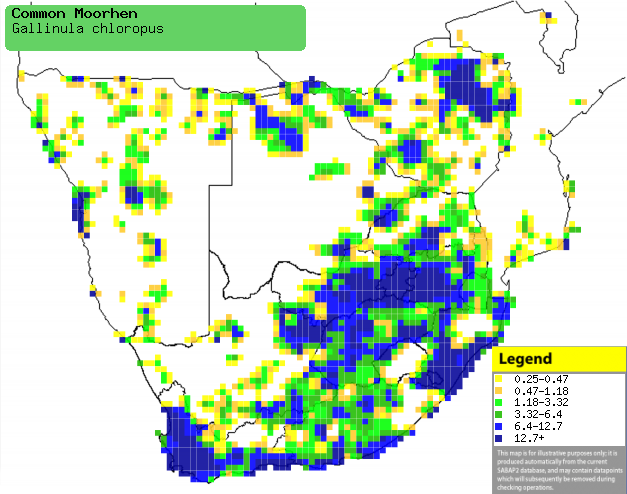 |
|
Distribution of Common moorhen in southern Africa,
based on statistical smoothing of the records from first SA Bird Atlas
Project (©
Animal Demography unit, University of
Cape Town; smoothing by Birgit Erni and Francesca Little). Colours range
from dark blue (most common) through to yellow (least common).
See here for the latest distribution
from the SABAP2. |
Predators and parasites
Movements and migrations
Resident and largely sedentary, although it may
move in response to changing water levels.
Food
Omnivorous and opportunistic, feeding on a variety of
invertebrates, seeds, fruit, birds eggs and tadpoles. It does most of its
foraging by walking on floating plants or swimming, grabbing prey from
vegetation, the ground and the water surface. The following food items have been recorded
in its diet:
- Animals
- invertebrates
- vertebrates
- tadpoles
- small fish
- carrion
- offal
- bird eggs
- Plants
Breeding
- Monogamous, territorial solitary nester, breeding in cooperative groups
which usually consist of the breeding pair and a number of helpers. These
are usually juveniles from the previous brood brought up by the pair, as it
usually rears multiple broods per breeding season.
- The nest (see images below) is built by the female with material
provided by the male, consisting of a a shallow bowl of plant stems and
sedges. It is typically hidden in or between clumps of reeds (Phragmites),
sedges or Bulrushes (Typha capensis), or in the low branches of a
flooded tree.
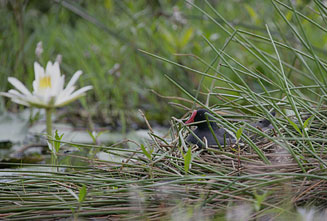 |
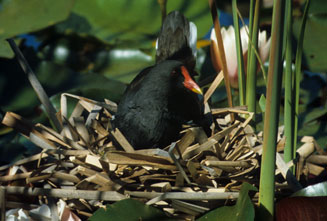 |
|
Common moorhen at its nest, Kgomo-Kgomo, South
Africa. [photo
Warwick Tarboton ©] |
Common moorhen on nest. [photo Peter Steyn
©] |
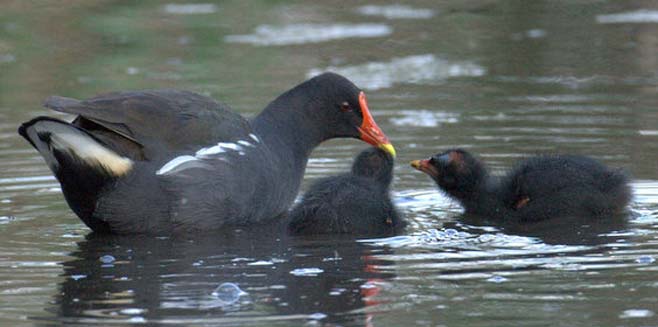 |
|
Common moorhen with chicks, Paarl Bird Sanctuary,
South Africa. [photo Trevor Hardaker ©] |
- Egg-laying season is year-round, peaking from June-August in Zimbabwe and
from August-March in South Africa.
- It lays 4-9 eggs, which are incubated by both sexes for about 21-22
days, with the female taking the day shift and the male taking the night
shift.
- The chicks leave the nest within 1-2 days of hatching and are cared for
by both parents and helpers. They are capable of foraging for themselves at
approximately three weeks old, taking their first flight at 40-50 days old.
Threats
Not threatened, in fact it has benefited from the
construction of man-made impoundments.
References
-
Hockey PAR, Dean WRJ and Ryan PG 2005. Roberts
- Birds of southern Africa, VIIth ed. The Trustees of the John Voelcker
Bird Book Fund, Cape Town.
|
